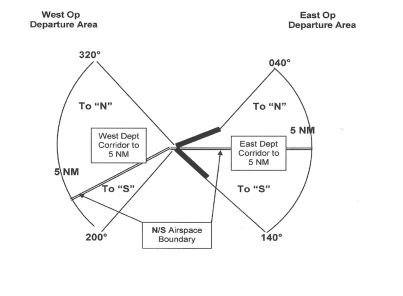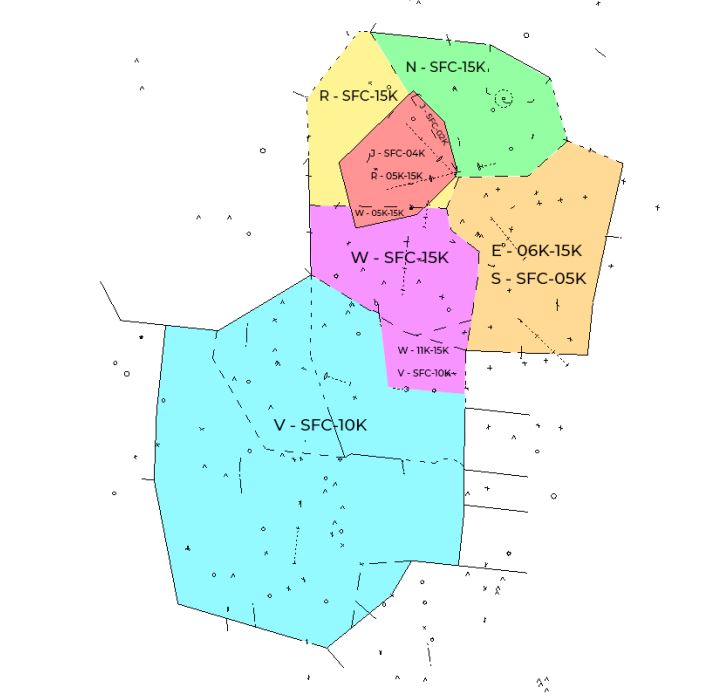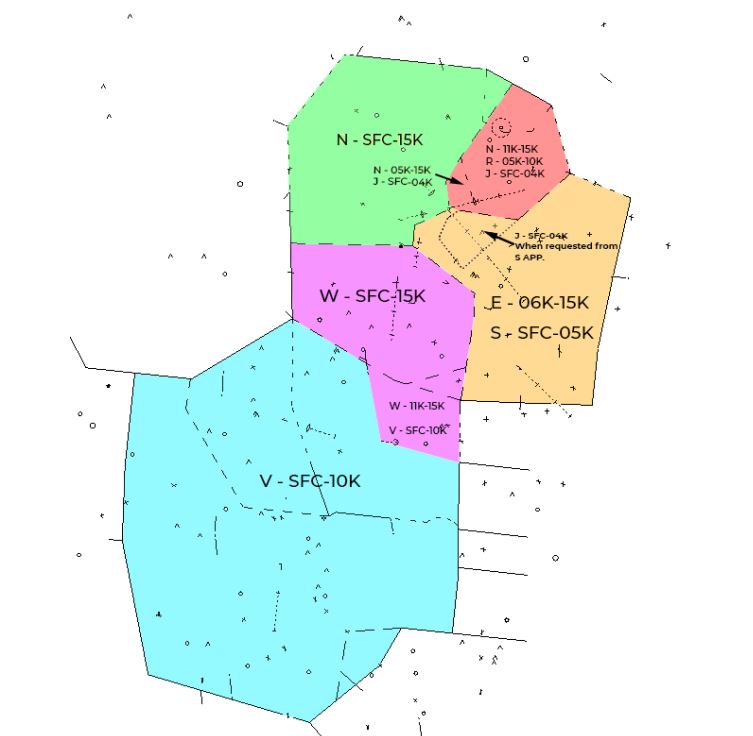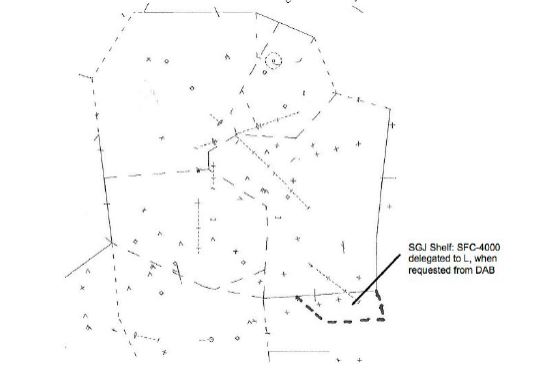JAX SOP
Table of Updates
| Date | Revision | Items Revised |
|---|---|---|
| 17 April 2023 | A | Calm Wind Departing and Arriving Runways |
Area Information
| ICAO Code | Airport Name | Airspace | IFR Beacon Codes | VFR Beacon Codes |
|---|---|---|---|---|
| KJAX | Jacksonville International Airport | C | 2601-2677 | 2601-2677 |
Purpose:
This document prescribes the procedures to be utilized for providing air traffic control services at the Jacksonville Air Traffic Control Tower (JAX ATCT) and TRACON. The procedures described herein are supplemental to the Jacksonville ARTCC Facility Operating Guidelines and FAA Order JO 7110.65, as well as any published FAA guidelines or procedures.
Distribution:
This order is distributed to all Jacksonville ARTCC personnel.
Operational Positions
| Position | Radio Name | Callsign | Relief Callsign | Symbol | Frequency |
|---|---|---|---|---|---|
| Clearance Delivery | Jacksonville Clearance Delivery | JAX_DEL | JAX_1_DEL | 3JD | 119.500 |
| Ground | Jacksonville Ground | JAX_GND | JAX_1_GND | 3JG | 121.900 |
| Tower | Jacksonville Tower | JAX_TWR | JAX_1_TWR | 3JT | 118.300 |
| Position | Sector Name | Callsign | Relief Callsign | Symbol | Frequency |
|---|---|---|---|---|---|
| N | Radar North | JAX_N_APP | JAX_1N_APP | 3N | 127.000 |
| W | Radar West | JAX_W_APP | JAX_1W_APP | 3W | 127.775 |
| E | Radar East | JAX_E_APP | JAX_1E_APP | 3E | 132.775 |
| R | Radar Arrival | JAX_R_APP | JAX_1R_APP | 3R | 119.000 |
| J | Radar Final | JAX_J_APP | JAX_1J_APP | 3J | 119.850 |
| S | Radar Satellite | JAX_S_APP | JAX_1S_APP | 3S | 120.750 |
| V | Radar Vitts | JAX_V_APP | JAX_1V_APP | 3V | 118.600 |
Sector in Red is the primary sector.
ATCT Information
IFR Departure Instructions
Clearance/Route
All aircraft not filing a SID, with a filled cruise altitude of 10,000 feet or above, shall be assigned the JAX# depature. All aircraft not filing a SID, witha filed cruise altitude below 10,000 feet, shall be assigned radar vectors to their first fix. All routes must comply with LOA-approved standards. Aircraft unable to accept preferred route require coordination between all affected facilities.
Note: KJAX RNAV Depatures are Turbojet Only Departures. Ensure that all non turbojet aircraft are on appropriate SIDs and STARs.
Altitude
Instruct all pilots to maintain 3,000 feet and to expect filed cruise altitude (If higher) ten minutes after departure. All filed cruise altitudes must be checked for validity for the direction of flight and/or LOAs.
Note: All ATL/PDK bound traffic should be filed at an odd altitude AOB FL310.
Note: all flights outbound on the east side of the FL peninsula shall be assigned an even altitude if landing within the zma airspace.
Departure Frequency
The Primary Departure Frequency is JAX_N_APP on 127.000 Updates to the Departure Frequency will be given by the TRACON controller.
Transponder
All departing aircraft shall be assigned a trasnponder code between 2601-2677.
VFR Departure Instructions
Altitude
If Aircraft is not remaining in the pattern, issue the instruction "Maintain VFR at or below 3,000 feet".
Departure Frequency
VFR aircraft not remaining within the pattern shall be given a departure frequency. The Primary Departure Frequency is JAX_N_APP on 127.000 Updates to the Departure Frequency will be given by the TRACON controller.
Transponder
All VFR aircraft not remaining in the pattern shall be assigned a transponder code between 2601-2677.
Scratch Pads
To assist the TRACON controllers, CD shall input the apporpriate scratchpad entries intot he flight plan after the clearance has been issued.
| SID/Type of Flight | Entry |
|---|---|
| ARNEY# | ARN |
| CROSB# | CRO |
| EXBOX# | EXB |
| JAX# | JAX |
| JETIN# | JET |
| SAWGY# | SAW |
| VFR Flight Following | VFF |
Note: Aircraft that do not request flight following do not need a scratchpad entry
Pushback and Startup
GC does not authorize pushbacks or startups unless the aircraft
pushing back will enter a controlled area during pushback.
- In these instances, aircraft should be instructed “Push and start approved, push tail facing (direction).” The direction should keep the aircraft pointed in the direction the aircraft will taxi.
- If the pilot calls to push, and no controlled area will be penetrated, simply advise the pilot “Push and start at pilot's discretion.”
Intersection Departure
GC must advise LC of all intersection departures verbally or through the chatbox.
ATIS
GC shall ensure pilots have the current ATIS prior to the aircraft being handed off to LC.
Active Runway Operations
GC must transfer communications to LC if an aircraft is to operate on an active runway.
Handoffs
GC shall instruct aircraft to “Contact Jacksonville Tower 118.300” unless otherwise agreed upon by LC. LC can request pilot monitor the frequency instead of contacting.
Area of Responsiblity
LC has responsibility for a five mile radius from the JAX field from surface up to and including 3,000 MSL.
Active Runway Selection
The active runway shall be determined based on wind and known factors that may affect the safety of takeoff/landing operations. East Operations is designated as the calm wind runway
Operations
East Operations: Runway 8 and 14. It is recommended that VFR traffic remaining in the pattern use runway 8.
West Operations: Runway 26 and 32. It is recommended that VFR traffic remaining in the pattern use runway 26.
Departure Procedures
LC will provide separation for aircraft in the LC airspace. LC shall provide initial radar separation between successive departures. When automatic departures are in effect, IFR jet/turbojet departures shall be released on the appropriate heading climbing to 3,000 feet. When automated departures are in effect, VFR may be released on the appropriate heading climbing at or below 3,000.
Departure Headings
Standard Turbojet Dearture Headings
East Operations
Runways 8 and 14 Traffic Departing to the South Sector: Heading 140.
Runway 8 Traffic Departing to the North Sector: Heading 080.
Runway 14 Trafic Departing to the North Sector: Heading 100.
West Operations
Runways 26 and 32 Traffic Departing to the South Sector: Heading 220.
Runway 26 and 32 Traffic Departing to the North Sector: Heading 320.
Exception: Traffic Going to the southwest during west operations will be given a heading of 320.
Standard PROP departure Headings
Assign an alternate departure heading as depicted to achieve separationg between IFR prop departures.

Arrival Procedures
LC shall be responsible for separation of all arrival aircraft that have
been handed off by TRACON from all departing aircraft still under LC
jurisdiction
Communication transfer must be completed prior to five nautical miles
from the runway.
Practice Instrument Approaches: Issue special instructions as verbally coordinated with the
TRACON.
A heading of 360 degrees and 2,000 feet will be given to aircraft conducting multiple approaches.
Upon completiong and leaving the multiple approaches pattern, standard departure heading and an altitude of 3,000 feet will then be assigned.
All aircraft conducting practice approaches will be handed to J.
LC shall NOT change the approach sequence without coordination.
Go Around/unplanned Missed Approach
East Operations: LC shall assign a heading of 070 and 2,000 feet.
West Operations: LC shall assign a heading of 320 and 2,000 feet.
LC must coordinate with TRACON verbally or via the chat box prior to a frequency change. Aircraft will be handed off to appropriate departure controller.
Automatic Release
LC is authorized automatic releases from the TRACON controller so long as the aircraft departs on the pre-coordinated active departing runway(s) on approved departure headings
In order for automatic releases to be authorized, procedures in this document shall be followed.
Departure releases must be obtained if automatic releases are suspended by TRACON.
Visual Tower
Jacksonville ATCT is a visual/VFR tower and shall
not initiate or accept any radar handoffs and shall not initiate control/start track on any target.
ATIS
LC shall manage the ATIS for KJAX.
VFR Pattern
The VFR pattern will be at or below 1,500 feet. Runway 8 and 32 will utilize left hand pattern. Runway 14 and 26 will utilize right hand pattern.
TRACON Information
Sectorization Description
The primary “combined” radar position shall be N. No other sectors shall be staffed until the “combined” position is already in use.
Once N is in use, N may delegate a portion of its airspace to W, E, R, J, S, or V depending on traffic volume in each sector.
Unless otherwise coordinated, areas of jurisdiction for the N, W, E, R, J, S, and V sectors are depicted
Handoff and Radar Tracking
Jacksonville ATCT is a VFR tower. No radar handoffs shall be initiated to LC.
TRACON controllers shall not drop track on any arriving aircraft. This allows a controller to maintain radar identification during missed approach.
Release and Rolling Calls
TRACON sectors give automatic releases to all departures from Jacksonville ATCT when departures follow the standard departure procedures as specified in this document.
All other airports within RAPCON’s boundaries shall request a departure release. Upon approval of the release, the release shall be good for five minutes.
Upon issuance of the takeoff clearance, a departure message shall be sent to the appropriate departure sector. This can be accomplished non-verbally by the LC ensuring the aircraft is squawking the appropriate squawk code and mode C is enabled when airborne.
TRACON Departure Procedures
During East Flow, Turbojets that are west or southwest bound should be vectored counterclockwise north of KJAX.
During West Flow, Turbojets that are northeast bound should be vectored clockwise north of KJAX.
Forward departure instructions to LC for aircraft executing practice missed approaches.
Ensure all departures are on course as soon as practical.
All departures should be on course before handoff to Enroute Control unless otherwise coordinated. Aircraft shall be climbed to 15,000 or less if filed.
Provide airspace for automatic departures and radar final.
Provide airspace for missed approach on all runways.
TRACON Arrival Procedures
The sector responsible for the primary runway shall establish the approach sequence for all arrivals.
Communications transfer of arriving aircraft to LC must be accomplished no later than five nautical miles from the end of the arrival runway.
When simultaneous approaches are being conducted on converging runways, LC is responsible for ensuring runway separation. However, TRACON must provide enough spacing to minimize the possibility of a go-around.
When vectoring to final from parallel downwinds, aircraft on opposing base legs shall be assigned altitudes to ensure vertical separation unless other approved separation has been applied. This ensures separation in the event of an overshoot on final.
Coordinate with LC for any aircraft conducting approaches to other runways than the active arrival runway(s) in use.
Responsibility
Provide overflight services and initial approach sequence to aircraft landing in the Jacksonville ATCT airspace. This includes the LUNNI# STAR in east flow and the LUNNI#, OHDEA#, MARQO# and AMG# STARs in west flow.
Depature Procedures
East Flow: Responsible for aircraft on the ARNEY# and CROSBY# SID, and other non-RVAV NW and NE bound departures. If on the JETIN# SID or westbound on the JAX# SID, aircraft shall be transferred as soon as practical to R if online.
West Flow: Responsible for aircraft on the ARNEY# , CROSBY# and JETIN#.CAPPS SID, and other non-RVAV NW and NE bound departures.
Responsibility
Provide overflight services and initial approach sequence to aircraft landing in the Jacksonville ATCT airspace. This includes the MARQO#, OHDEA#, AMG# in east flow and LUNNI# STAR after transfer from N in west flow.
Depature Procedures
Responsible for aircraft on the JETIN#.CAPPS SID, the JETIN#.JAYJA SID during east flow, and other non-RVAV west bound departures after transfer from N.
Responsibility
Provide overflight services and approach sequence to airports landing in the Jacksonville ATCT airspace. This includes the HOTAR# STAR and primarily satellite field arrivals.
Depature Procedures
E has authorization for airspace penetration with S for southern departures from JAX for climbs and turns. E assumes responsibility for separation from other traffic and must not interfere with S operations. This sector is responsible for the SAWGY# and EXBOX# SIDs.
Arrival Procedures
J has control for turns and descent at or below 5,000 feet and within 10 miles of E airspace. E shall provide final approaches to JAX for Runway 32 when J is not staffed.
Responsibility
Provide overflight services and approach sequence to aircraft landing in the Jacksonville ATCT airspace. This includes the TEBOW# STAR.
Depature Procedures
Responsible for aircraft on the JETTIN#.JAYJA during west flow. W is also responsible for arrival/departures from VQQ, and responsible for conducting arrivals into NIP when NIP is east, as well as departures when NIP is west.
Responsibility
J shall provide overflight service, arrival sequence, and departure sequence to airports within J’s airspace
Arrival Procedures
J shall retain responsibility for separation between successive instrument approaches. J has control for turns and descent of aircraft at or below 5,000 feet and within 10 miles of J airspace when handed off adjacent sectors. When JAX is in west operations, J may coordinate with E for the “32 final” airspace as depicted.
Responsibility
S is a low-level arrival sector for CRG, NRB, and SGJ. S shall provide overflight service, arrival sequence, and departure sequence to airports within S’s airspace.
Depature Procedures
S serves as the initial departure controller for all airports within its boundaries except for JAX.
Ensure all departures are on course as soon as practical.
Aircraft shall be climbed to 5,000 or less (if filed) and handed off to the appropriate sector.
The JAX final and departure corridors shall be protected from northbound departures from S. Traffic should be routed around or above the final and departure corridors.
For departures from JAX, S has authorization for airspace penetration for climbs and turns. S assumes responsibilities for separation, but S maintains responsibility for issuing appropriate traffic information.
S is responsible for conducting departures from NIP when NIP is in east operation.
Arrival Procedures
During JAX west operations, S is responsible for sequencing arrivals to Runway 32 unless the “32 Final” has been released to S.
The St. Augustine Shelf Airspace may be activated when necessary due to traffic. Coordinate with DAB_APP or JAX_CTR for use of this shelf airspace.
S is responsible for conducting approaches into NIP when NIP is in west operation.
Responsibility
V is a low level arrival sector for GNV, and OCF. V shall provide overflight service, arrival sequence, and departure sequence to airports within V’s airspace.
Depature Procedures
V serves as the initial departure controller for all airports within its boundaries. Ensure all departures are on course as soon as practical. Aircraft shall be climbed to 10,000 feet or less (if filed) and handed off to the next appropriate sector.


